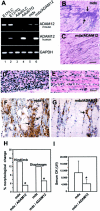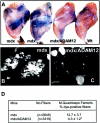ADAM12 alleviates the skeletal muscle pathology in mdx dystrophic mice
- PMID: 12414501
- PMCID: PMC1850802
- DOI: 10.1016/S0002-9440(10)64431-8
ADAM12 alleviates the skeletal muscle pathology in mdx dystrophic mice
Abstract
Muscular dystrophy is characterized by muscle degeneration and insufficient regeneration and replacement of muscle fibers by connective tissue. New therapeutic strategies directed toward various forms of muscular dystrophy are needed to preserve muscle mass and promote regeneration. In this study we examined the role of the transmembrane ADAM12, a disintegrin and metalloprotease, which is normally associated with development and regeneration of skeletal muscle. We demonstrate that ADAM12 overexpression in the dystrophin-deficient mdx mice alleviated the muscle pathology in these animals, as evidenced by less muscle cell necrosis and inflammation, lower levels of serum creatine kinase, and less uptake of Evans Blue dye into muscle fibers. These studies demonstrate that ADAM12 directly or indirectly contributes to muscle cell regeneration, stability, and survival.
Figures



Similar articles
-
Compensation for dystrophin-deficiency: ADAM12 overexpression in skeletal muscle results in increased alpha 7 integrin, utrophin and associated glycoproteins.Hum Mol Genet. 2003 Oct 1;12(19):2467-79. doi: 10.1093/hmg/ddg264. Epub 2003 Aug 5. Hum Mol Genet. 2003. PMID: 12915458
-
Transgenic overexpression of ADAM12 suppresses muscle regeneration and aggravates dystrophy in aged mdx mice.Am J Pathol. 2007 Nov;171(5):1599-607. doi: 10.2353/ajpath.2007.070435. Am J Pathol. 2007. PMID: 17982130 Free PMC article.
-
ADAM12 overexpression does not improve outcome in mice with laminin alpha2-deficient muscular dystrophy.Neuromuscul Disord. 2005 Nov;15(11):786-9. doi: 10.1016/j.nmd.2005.06.019. Epub 2005 Sep 29. Neuromuscul Disord. 2005. PMID: 16198565
-
Oxidative stress and pathology in muscular dystrophies: focus on protein thiol oxidation and dysferlinopathies.FEBS J. 2013 Sep;280(17):4149-64. doi: 10.1111/febs.12142. Epub 2013 Feb 15. FEBS J. 2013. PMID: 23332128 Review.
-
Skeletal muscle in health and disease.Dis Model Mech. 2020 Feb 6;13(2):dmm042192. doi: 10.1242/dmm.042192. Dis Model Mech. 2020. PMID: 32066552 Free PMC article. Review.
Cited by
-
Distinct genetic regions modify specific muscle groups in muscular dystrophy.Physiol Genomics. 2011 Jan 7;43(1):24-31. doi: 10.1152/physiolgenomics.00172.2010. Epub 2010 Oct 19. Physiol Genomics. 2011. PMID: 20959497 Free PMC article.
-
The TWEAK-Fn14 system is a critical regulator of denervation-induced skeletal muscle atrophy in mice.J Cell Biol. 2010 Mar 22;188(6):833-49. doi: 10.1083/jcb.200909117. J Cell Biol. 2010. PMID: 20308426 Free PMC article.
-
Increasing alpha 7 beta 1-integrin promotes muscle cell proliferation, adhesion, and resistance to apoptosis without changing gene expression.Am J Physiol Cell Physiol. 2008 Feb;294(2):C627-40. doi: 10.1152/ajpcell.00329.2007. Epub 2007 Nov 28. Am J Physiol Cell Physiol. 2008. PMID: 18045857 Free PMC article.
-
Cooperation of the metalloprotease, disintegrin, and cysteine-rich domains of ADAM12 during inhibition of myogenic differentiation.J Biol Chem. 2005 Jun 24;280(25):23475-83. doi: 10.1074/jbc.M413550200. Epub 2005 Apr 23. J Biol Chem. 2005. PMID: 15849365 Free PMC article.
-
Transgenic expression of {alpha}7{beta}1 integrin maintains muscle integrity, increases regenerative capacity, promotes hypertrophy, and reduces cardiomyopathy in dystrophic mice.Am J Pathol. 2005 Jan;166(1):253-63. doi: 10.1016/s0002-9440(10)62249-3. Am J Pathol. 2005. PMID: 15632017 Free PMC article.
References
-
- Cohn RD, Campbell KP: Molecular basis of muscular dystrophies. Muscle Nerve 2000, 23:1456-1471 - PubMed
-
- O’Brien KF, Kunkel LM: Dystrophin and muscular dystrophy: past, present, and future. Mol Genet Metab 2001, 74:75-88 - PubMed
-
- Muntoni F, Guicheney P: 85th ENMC International Workshop on Congenital Muscular Dystrophy. 6th International CMD Workshop. 1st Workshop of the Myo-Cluster Project ‘GENRE’.27–28th October 2000, Naarden, The Netherlands. Neuromuscul Disord 2002, 12:69-78 - PubMed
-
- Burton EA, Davies KE: Muscular dystrophy—reason for optimism? Cell 2002, 108:5-8 - PubMed
-
- Dubowitz V: Therapeutic possibilities in muscular dystrophy: the hope versus the hype. Neuromuscul Disord 2002, 12:113-116 - PubMed
MeSH terms
Substances
LinkOut - more resources
Full Text Sources
Other Literature Sources
Medical
Molecular Biology Databases

